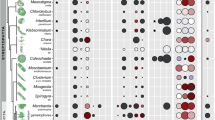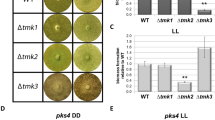Abstract
RECENTLY, it was found that sterols induce the formation of oogonia in certain species of Pythium1 and Phytophthora2. We have shown that the response of these organisms to sterols depends on the composition of the medium in which they are grown3. This communication shows that zinc and manganese as well as sterol are essential to oogonium formation in an isolate of Pythium graminicola; calcium seems to be required for maturation of oogonia. Zinc, manganese and sterol are also very stimulatory to the vegetative growth of this fungus.
This is a preview of subscription content, access via your institution
Access options
Subscribe to this journal
Receive 51 print issues and online access
$199.00 per year
only $3.90 per issue
Buy this article
- Purchase on Springer Link
- Instant access to full article PDF
Prices may be subject to local taxes which are calculated during checkout
Similar content being viewed by others
References
Haskins, R. H., Tulloch, A. P., and Micetich, R. G., Canad. J. Microbiol., 10, 187 (1964).
Hendrix, J. W., Science, 144, 1028 (1964).
Klemmer, H. W., and Lenney, J. F., Phytopathology, 55, 320 (1965).
Tukey, J. W., in Experimental Design, edit. by Federer, W. T. (The Macmillan Co., New York, 1955).
Fothergill, P. G., and Hide, D., J. Gen. Microbiol., 29, 325 (1962).
Author information
Authors and Affiliations
Rights and permissions
About this article
Cite this article
LENNEY, J., KLEMMER, H. Factors controlling Sexual Reproduction and Growth in Pythium graminicola. Nature 209, 1365–1366 (1966). https://doi.org/10.1038/2091365a0
Issue Date:
DOI: https://doi.org/10.1038/2091365a0
This article is cited by
-
Probability Models Based on Soil Properties for Predicting Presence-Absence of Pythium in Soybean Roots
Microbial Ecology (2017)
-
A new species of Pythium from Algerian waters
Hydrobiologia (1986)
Comments
By submitting a comment you agree to abide by our Terms and Community Guidelines. If you find something abusive or that does not comply with our terms or guidelines please flag it as inappropriate.



